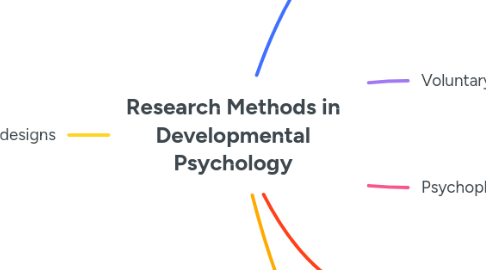
1. Research designs
1.1. Cross-sectional
1.1.1. Changes across different groups, at that time
1.2. Sequential
1.2.1. Changes within groups of individuals of different ages, both over time and at that time
1.2.1.1. Allows examination of cohort effects
1.2.1.2. Less attrition and practice effects
1.3. Longitudinal
1.3.1. Changes within individuals over time
1.3.1.1. Cons
1.3.1.1.1. Attrition (failure to complete all portions of a study
1.3.1.1.2. Practice effect (better by practice, not due to natural psychological development)
1.3.1.1.3. Cohort effects (historical context and culture and technological changes over time)
1.3.1.2. Pros
1.3.1.2.1. Allows in depth developmental analysis
2. Involuntary/Obligatory Responses
2.1. Behaviours engaged in without much conscious thought or effort, in response to environmental stimuli
2.1.1. Habituation
2.1.1.1. Infants are more interested in novel stimuli
2.1.1.2. Continuous presentation of a stimulus, til the infant grows bored and looks away from the stimuli
2.1.2. Dishabituation
2.1.2.1. Following habituation, infants are shown a novel stimulus and their interest returns and they look at it
3. Voluntary Responses
3.1. Behaviours completed by choice
3.1.1. Recall memory
3.1.1.1. Memory of past events
4. Psychophysiological Responses
4.1. Measure heart rate, hormone levels or brain activity to better understand the bidirectional relations between biology and behaviour
5. Parent-report questionnaires
5.1. eg Child Behaviour Checklist (CBCL), and CBCL-Preschool
6. Interview techniques
6.1. Verbal report paradigms
6.1.1. Children presented with a short story etc, describing a moral dilemma and ask child to give their thoughts and beliefs, either verbally or written answer
6.1.1.1. Allows children to describe their own experience of the world
